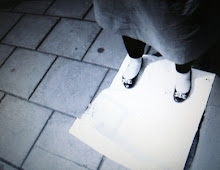Post thoughts: This is thoughts in an alternate location. This is thoughts on the train. These are thoughts post thought I will transcribe in their exact state. I will not interfere with these post thoughts.
___
The aesthetic of so much of the work was similar- someone commented that it was “generational” the impact of the machine on the text. The control of performance being passed to the machine. What impact does this have on the ownership of the writing?
I am interested in this being “BEYOND TEXT” when so much of the work concentrated on the PRESENCE of text and showing text. I am not criticising this aesthetic but am interested in why, in most of these performances text was not undergoing any change. Liveness brings with it a risk to expose the materiality of the text and this was not being done. In Robin Deacon’s work at the end of this piece he reads from a variety of scripts – provided by his father- his live reading of these created a new text in performance. It allowed for interaction between text and body which was spontaneous.
SPONTANEOUS: LIVENESS: versus DEADNESS
(this term DEADNESS was mentioned by an audience member in the discussion following the performances. I will use this term, not as a term which implies a deadness of the performers, but as a term to address the binary of live.) The materiality of the LIVE text was not dealt with in performance- texts were eing typed in front of us BUT they were not being produced. This is what interests me. the text which was performing was not live. All these artists engaged with the materiality of writing and exposed the “act” and “action” of writing, but we did not see this truly as- “generation” of text was not happening.
I suppose this is why I raised the question of all of the mistakes in the typing- I asked why mistakes made in the live typing of text which was being projected to the audience, why were these mistakes corrected? Are these mistakes not a true mark of liveness? Of the body? Of the present? Of the space? It is these mistakes which were glimpses of true liveness for me, which generated a document of the performance, which encouraged a new, live generated text to come into being. These mistakes allowed a translation of the prewritten text to be created through performance. And in performance we are translating; moving from a page to a bodily enactment. This process through body, which all the performances dealt with is of interest. These mistakes act as a trace that this performance occurred. These mistakes show that performance is a translation not a reproduction.
I was interested in how these two words come into play.
TRANSLATION of the text in performance and REPRODUCTION.
I am unsure whether these are the right terms – but I will explain them as I see them in terms of performance.
TRANSLATION: to undertake change from one form to another. From one language to another. To translate is to communicate. To translate a text is to communicate it to another. To change its form – to communicate this “new” form using the tools of this “new” language.
REPRODUCTION: to reproduce is to RE-produce. To produce again to produce again. In a reproduction we expect no faults, we expect the production the reproduction.
So now I have returned from these statements and considered translation to be of more interest, of more relevance to exposing text and its status as object. I want to say I enjoyed this event. That I appreciated all the hard work. That I appreciated the coming together of people and level of audience interest. To see where text is now. To see how text is being treated in performance. To consider where text should be. And why it should be in performance. My words of documentation are written in the dark. These words now are written on the train returning to Waterloo. These words are considerations of the ongoing question. These writings are asking and answering questions. These writings are the effects of a day spent with people. These writings are reactions. These writings will continue. And these writings are writing.
Subscribe to:
Post Comments (Atom)

No comments:
Post a Comment